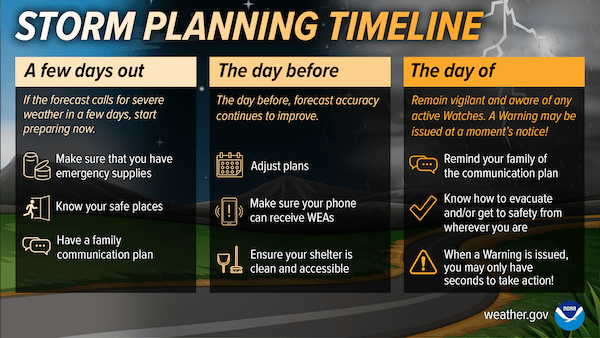“Tornado Alley” is a loosely defined location of the central United States where tornadoes are most frequent. There are no official boundaries of Tornado Alley, but the area common to most definitions extends from Texas, through parts of Oklahoma, Kansas, Nebraska, South Dakota, Iowa, Minnesota, Wisconsin, Missouri, and eastern portions of Colorado and Wyoming. However, a growing body of research indicates that regions in the south and east are now at greater risk for tornadoes than some in the Midwest.
An analysis by USA Today found that 20 US states saw an increase in tornado activity between 2000 and 2019, compared to data from 1980 to 1990. The upward trend outside tornado alley includes a wide swath from Illinois to Louisiana, stretching eastward to North Carolina. The spike in activity has included what are known as “tornado swarms,” events where ten or more tornadoes are formed by the same storm system within a couple of days. For instance, on April 25-27, 2011, more than 300 separate twisters cut a devastating path from Oklahoma to North Carolina that killed at least 320 people.
The USA Today analysis backs up other research that indicates tornado activity has changed across the US. A 2018 study found that tornado frequency generally decreased over the past four decades across Tornado Alley while increasing just to the east across the Lower Great Lakes and into the Deep South.
Both tornado reports and tornado environments indicate an increasing trend in portions of Mississippi, Alabama, Arkansas, Missouri, Illinois, Indiana, Tennessee, and Kentucky. Some meteorologists have begun calling this region “Dixie Alley” in a nod to the region’s increased tornado activity. The Southeast already represents a maximum in the occurrence of tornado casualties.
It’s not clear what has caused the shift but some believe the uptick is part of an overall increase in severe weather across the US due to climate change. Climate models have been forecasting this for years. However, others note that the variability may stem from bigger cycles, such as differences in Pacific sea surface temperatures. Many tornadoes are born in storms that form in warm, moist air off the Gulf of Mexico, and the warming of these waters is accelerating. Others believe it is part of a natural weather cycle.
Bottom line, researchers really don’t know why tornado activity is shifting but it is important for residents of the Southeast to be aware of the heightened threat. Tornado season typically runs from March through June, but they can really happen anytime.
Tornado intensity is measured by the “Enhanced Fujita scale” which rates the damage they cause on a scale from 0 to 5, with 5 being the most catastrophic. Experts stress that if you know what to do before, during, and after a tornado, you will minimize your risk of injury and increase your chances of survival.
Tornado safety begins with understanding the difference between Tornado Watch and a Tornado Warning issued by the National Weather Service (NWS):
Tornado Watch: Be Prepared! Tornadoes are possible in and near the watch area. Review and discuss your emergency plans and check supplies and your safe room. Be ready to act quickly if a warning is issued or you suspect a tornado is approaching. Watches are issued by the Storm Prediction Center for counties where tornadoes may occur. The watch area is typically large, covering numerous counties or even states.
Tornado Warning: Take Action! A tornado has been sighted or indicated by weather radar. There is imminent danger to life and property. Move to an interior room on the lowest floor of a sturdy building. Avoid windows. If in a mobile home, a vehicle, or outdoors, move to the closest substantial shelter and protect yourself from flying debris. Warnings are issued by your local forecast office. Warnings typically encompass a much smaller area (around the size of a city or small county) that may be impacted by a tornado identified by a forecaster on radar or by a trained spotter/law enforcement who is watching the storm.
It’s also important to prepare now while the weather is calm for a possible tornado. The NWS offers these tips:
Be Weather-Ready: Check the forecast regularly to see if you’re at risk for tornadoes. Listen to local news or a NOAA Weather Radio to stay informed about tornado watches and warnings.
Sign Up for Notifications: Know how your community sends warnings. Some communities have outdoor sirens. Others depend on media and smart phones to alert residents of severe storms capable of producing tornadoes.
Create a Communications Plan: Have a family plan that includes an emergency meeting place and related information. If you live in a mobile home or home without a basement, identify a nearby safe building you can get too quickly, such as a church or family member.
Pick a safe room in your home, such as a basement, storm cellar, or an interior room on the lowest floor with no windows. Check more ideas for your family plan HERE.
Practice Your Plan: Conduct a family severe thunderstorm drill regularly so everyone knows what to do if a tornado is approaching. Make sure all members of your family know to go there when tornado warnings are issued. Don’t forget pets if time allows.
Prepare Your Home: Consider having your safe room reinforced. You can find plans for reinforcing an interior room to provide better protection on the Federal Emergency Management Agency website HERE.
Help Your Neighbor: Encourage your loved ones to prepare for the possibility of tornadoes. Take CPR training so you can help if someone is hurt.
For more information, visit the NWS Tornado Safety website HERE.










